As they say, the kitchen is the heart of the home. This couldn’t be more true when it comes to farmhouse kitchen design.
While every kitchen holds a story, some have a way of drawing you in and making you feel truly at home the moment you sit down and pull up to the counter. I believe, as a designer, that’s what draws so many to farmhouse style.
The amazing thing about farmhouse kitchens is that they are quite timeless and have never gone out of style.
In its true form, a farmhouse kitchen served as a place where families preserved the harvest, shared meals from hand written recipes, and caught up over coffee or tea. Not much has changed, and the elements that make a farmhouse kitchen beautiful have withstood the test of time.
We still want that same inviting atmosphere; the feeling of welcome and warmth…in a way that works for how we live now.
I’ve seen amazing kitchens in English cottages, as well as France, that ooze the traditional farmhouse look. That said, you don’t need to live on a farm or gut your kitchen to get that farmhouse feel. What’s important is knowing what makes these spaces special – it’s all in the details. Maybe it’s the worn edges of a butcher block that’s seen thousands of meals or new cabinets crafted with old-world care. The best farmhouse kitchens have soul, not just trend.
I am an interior designer, and it just so happens that I got my start designing farmhouse kitchens. It’s actually one of the things I’m most known for. I’ve been feature in Modern Farmhouse Style magazine, Country Home, and many more. All for: Farmhouse Kitchen Design Inspiration.
So, welcome! I am glad you’re here. I am truly passionate about creating timeless farmhouse kitchens that will withstand the test of time. Today I’m here to help you skip the generic farmhouse kitchen ideas and create something that feels right for your home, family, and how you live – for decades to come.
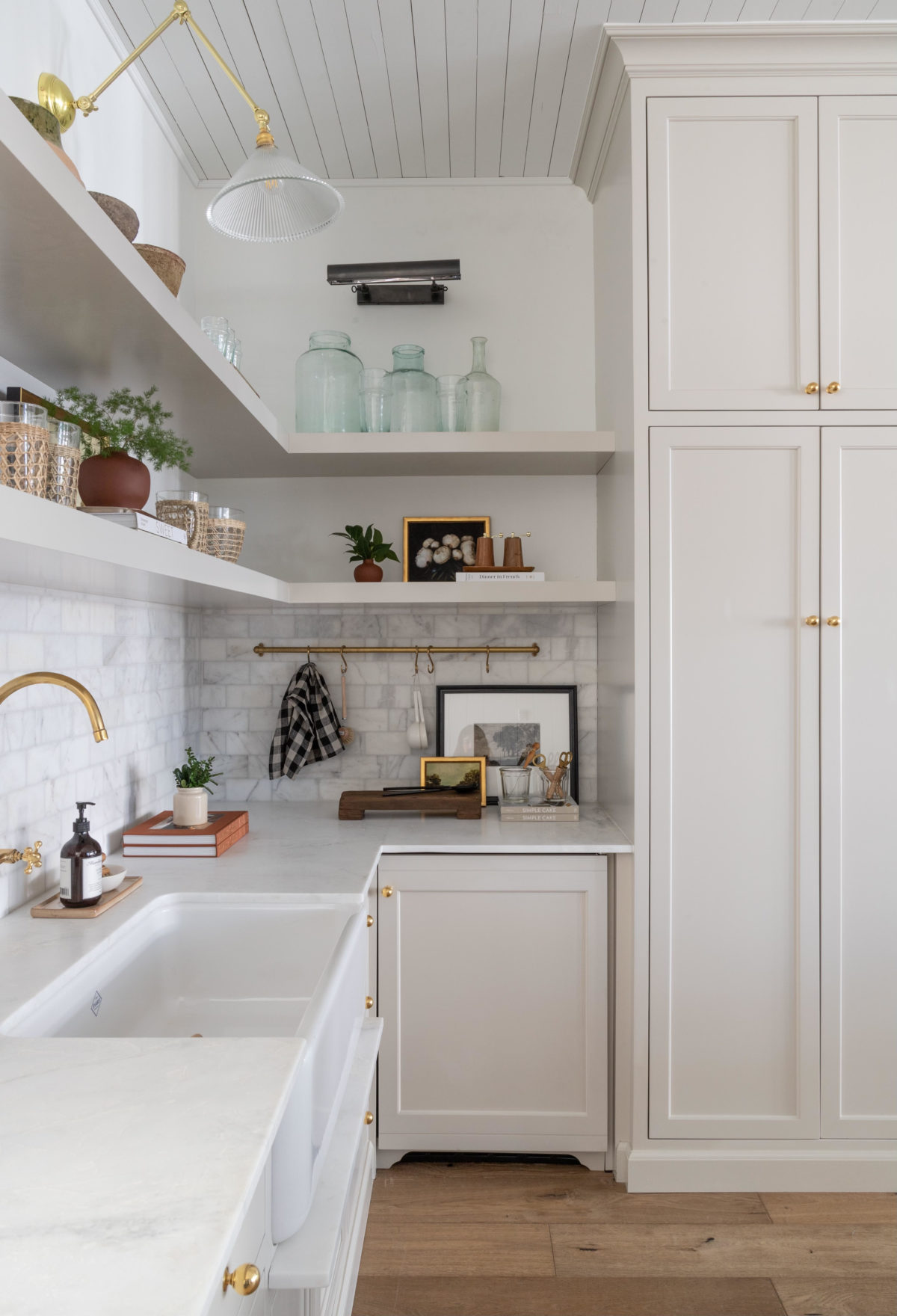
Table of contents
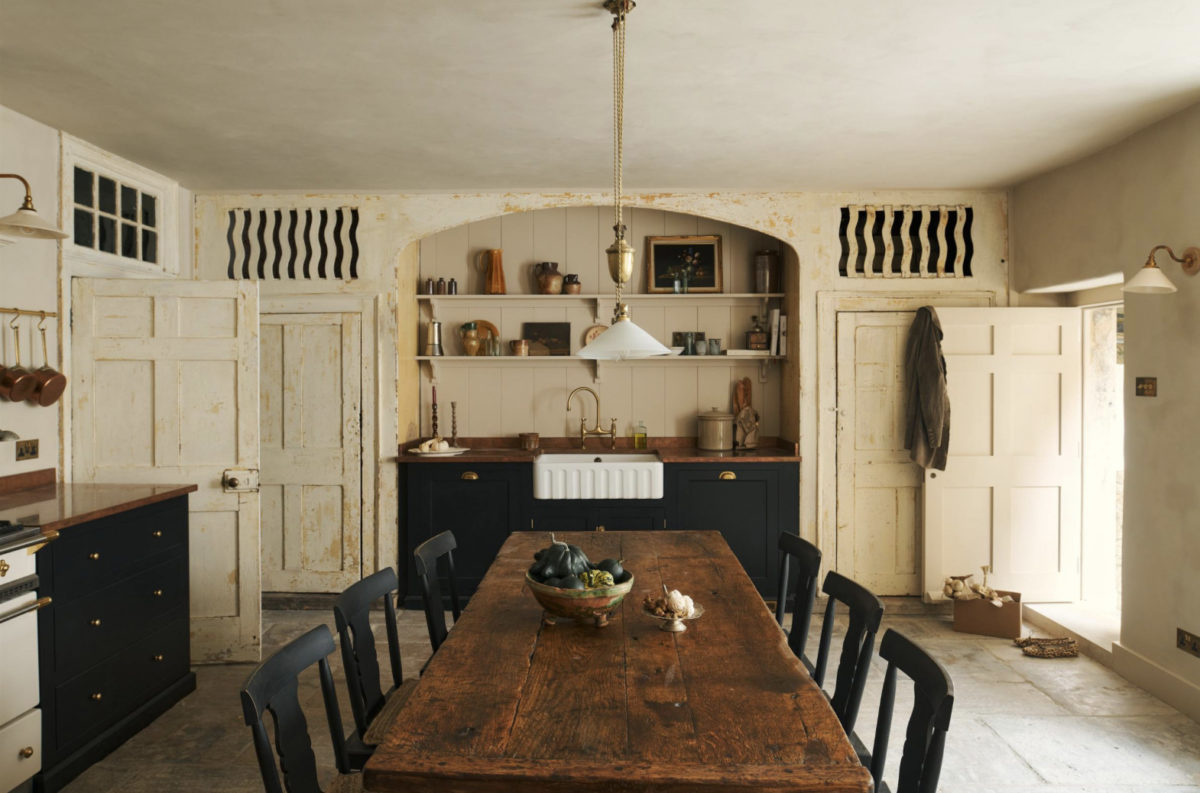
What Makes a Kitchen a Farmhouse Kitchen?
True farmhouse style starts with authentic materials and design choices. Think: wood beams, worn tables as islands, open shelves, and classic cabinetry design.
Design Tip: Try either a solid wood table or an island that’s meant for cooking, which can double as a dining table.
Authentic materials
You will always find natural materials in a real farmhouse kitchen – raw wood, real stone, proper metals – nothing pretending to be something it’s not. I’ve seen beautiful Shaker cabinets adorned with a touch of beading – subtle yet special.
Smart storage solutions
Farmhouse kitchens handle storage differently. I love adding:
- A row of hooks – for holding copper pots, or dish towels
- Open shelves that display everyday dishes
- Built-in plate racks
- Utility rails that keep things handy
- A full collection of glassware
Everything has its place, but nothing feels too precious or staged.
Natural hues
The best farmhouse kitchens feature a color palette inspired by nature.
Often we lean on warm whites and blend with natural woods. Sometimes, we’ll opt for muted greens or blues – or if you’re more of a country style, try a bold pop of color from Farrow & Ball.
READ MORE: The Best Farrow & Ball Paint Colors
Think of old farmhouse walls that have endured decades of sunlight, dinners, and generations – that’s the vibe. The finishes should develop a beautiful patina as they mature.
Farmhouse kitchens also have a spacious cooking area and central island, often with seating that is perfect for gathering.
Overall, if the kitchen has natural organic finishes, rustic accents, and a welcoming feel, you’ve nailed it.
8 Farmhouse Kitchen Ideas
The best farmhouse kitchen ideas are not only beautiful, but also functional. In its true form, farmhouse kitchens were all about functionality and utility. This is a wonderful way to create not only a rustic and welcoming kitchen, but also one that works for you!
Here are 8 ideas I swear by as a designer:
- Install light fixtures that make a statement
The right lighting transforms a farmhouse kitchen – and it’s simpler than you might think.
Let’s talk kitchen pendant size: Size absolutely matters when choosing pendant lights for your island. I prefer a 12″-18″ pendant over an island, or for a charming look, something around 8″. I love ribbed glass globes and ceramic shades, though metal domes can work beautifully, too.
Design Tip: Stay away from matte black or brushed finishes. Just trust me on that one.
For task lighting, we love placing sconces above the sink or bank of windows. They add a refined touch that recessed lighting can’t match. Of, it you have open shelving, adding sconces or picture lights above the shelves instantly elevates the space.
Where to buy farmhouse kitchen lighting? Shameless plug, we have the most beautiful handcrafted European lighting at Boxwood Avenue Mercantile. I also like Devol very much. As well as Etsy’s handmade lighting. For a true farmhouse look, opt for beautiful vintage lights!
Design Tip: Keep the overall vibe authentic – skip the industrial or ultra-modern shapes. Stick with honest materials and timeless designs that will endure.
- Incorporate Natural Elements (Organic Materials)
I can’t talk about farmhouse kitchen style without mentioning natural materials. Natural materials give a kitchen a cozy and authentic feel that can’t be faked.
Wood tones and textures
As a designer, I can’t stress this enough, wood is what brings warmth to your space.
Hardwood floors or engineered (not sure the difference? Read here!) are always a lovely base, but you can also wrap a ceiling beam in weathered oak or add butcher block countertops.
A pine table or island is always beautiful (I love Elsie Green). Opt for wood with a nice grain pattern like plain sawn or quarter sawn.
Natural stone options
When selecting stone countertops for your kitchen, authenticity is key. Here’s what works best (and why):
- Soapstone is probably my #1 choice for farmhouse, it’s a beautiful natural stone that will hold up well.
- Marble countertops are a classic choice and will always look good! Read More: Marble Countertop Guide
- Granite is a cost effective choice. Read my granite guide for tips!
- Avoid quartz countertops, and if I am honest, quartzite really isn’t the best look for a farmhouse kitchen!
Additionally, mix in stoneware and ceramics that are imperfect and handmade:
- Vintage Pottery
- Tiles that aren’t perfectly uniform – this is ideal!
- Hardware that feels worn and wonderful, again Etsy or Devol offer great options.
- Local pieces that tell your area’s story.
Wooden beams
Wooden beams are not just structural elements but also define the overall look of a farmhouse kitchen.
If you can find original beams, that is wonderful! Try local sources for reclaimed wood. You can also add box beams if solid beams aren’t an option.
I prefer the look of No. 1 Common White Oak. Maintain a natural finish for authenticity and place them where they make sense architecturally.
What to skip
Anything that isn’t true to its material. Ie: Don’t fall for quartz that looks like marble, faux wood materials, plastic laminates, and vinyl planks (just avoid these).
Mix it all together, but don’t overthink it. The best farmhouse kitchen decor comes together overtime. Let things be imperfect – nothing adds more rustic charm than that.
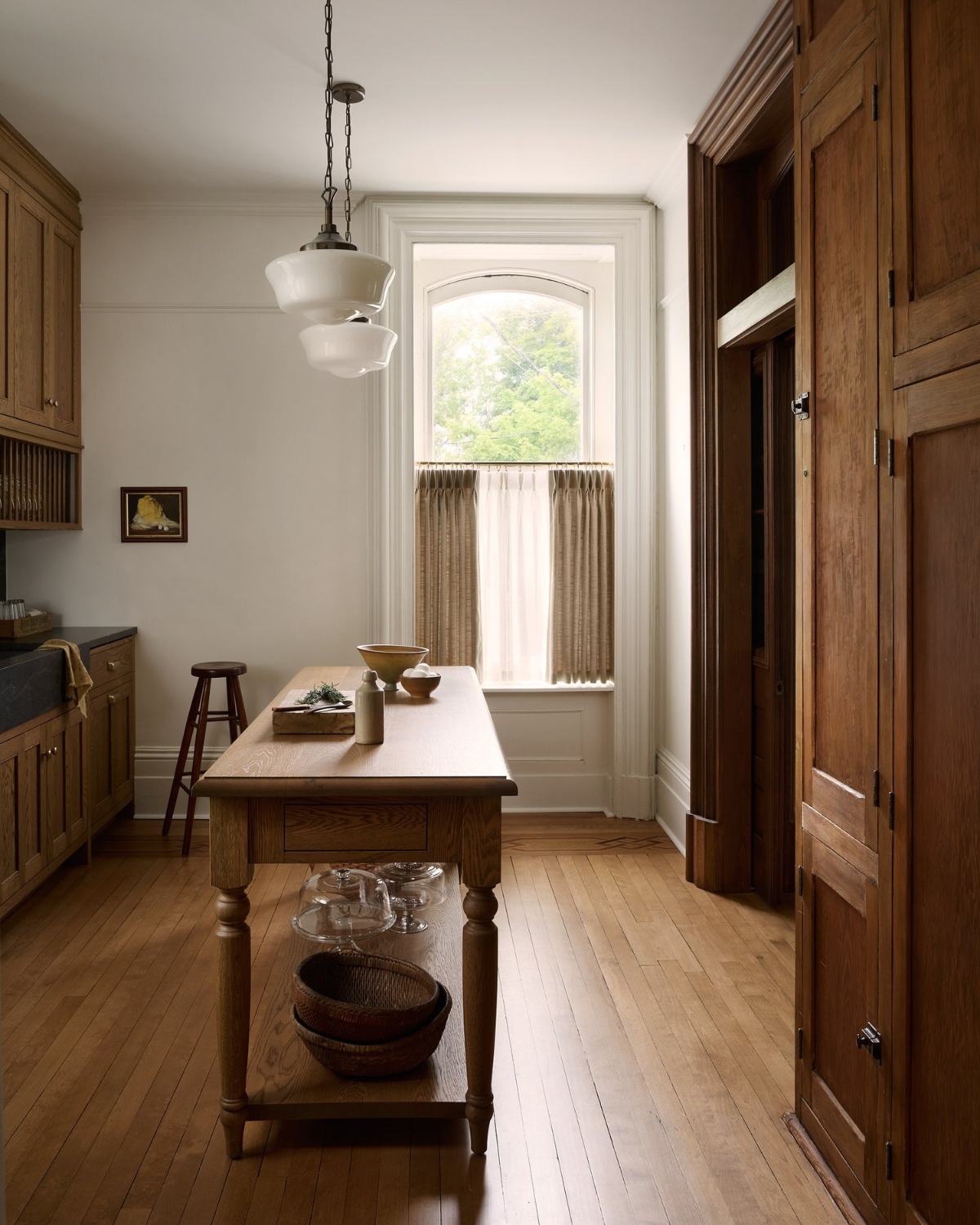
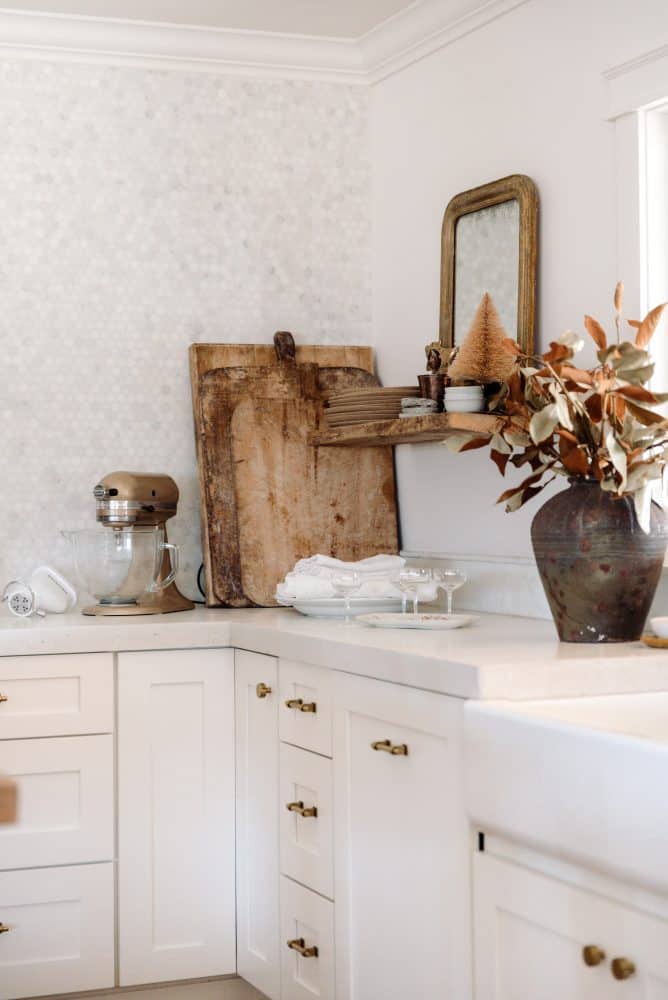
- The Farmhouse Sink
It wouldn’t be a farmhouse kitchen without a “farm sink”. Technically called an apron front sink, the nickname says it all. After a decade of speccing these out, here’s what I know to be true:
Farmhouse sink varieties
You have options besides white. The apron-front sink comes in fireclay, cast iron if you want something more durable, or copper that ages beautifully.
I do recommend a Shaws sink, they are truly the most timeless – see below.
Natural stone can also work well, especially if you want a smooth, seamless look. This is called an “integrated sink” – see below.
Shaws vs. Kohler
Shaws sinks are stunning, and the most classic. They are handcrafted in England and built to last. However, they are certainly an investment.
Kohler is a good alternative as it is a bit more affordable.
Integrated sink designs
An integrated sink is a beautiful and timeless farmhouse look. This is where the sink is made using the same material as the countertop for a fully integrated look. This is also a very high end look, it’s lovely.
Soapstone is a great option here (ask my friend Sarah owner of Chateau Sonoma – hers is stunning). Marble is also a good choice if you’re willing to maintain it carefully, and quartzite or granite is another excellent option.
Drip ledge details
The drip ledge may seem minor, but this little detail keeps water from seeping behind your sink and damaging your cabinets. Plus, it looks right – like it’s always been there.
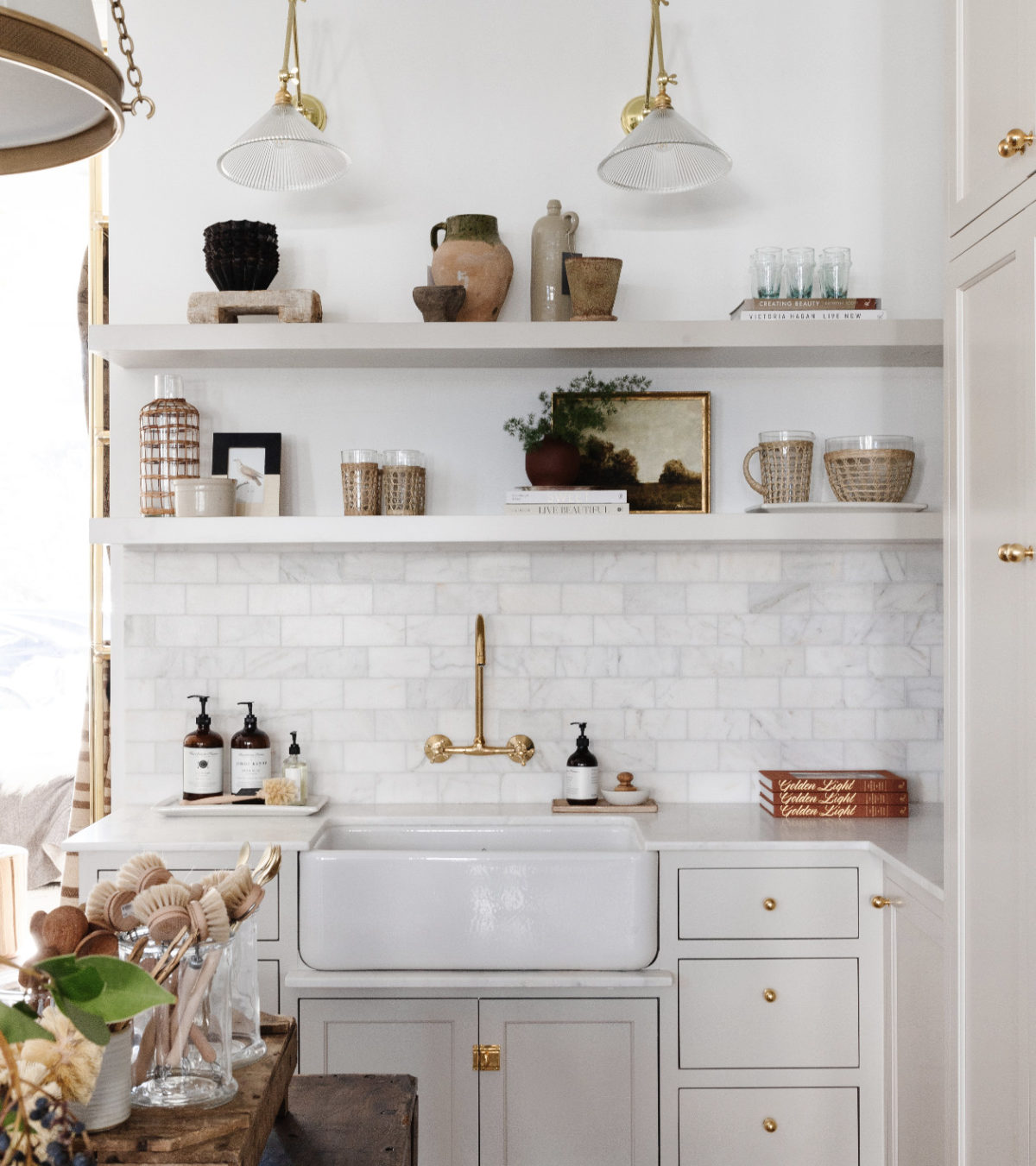
My tip? Pick a sink that works for how you cook and clean. The prettiest sink in the world won’t matter if it drives you crazy every time you do dishes. ;)
- Farmhouse Cabinet Ideas that Endure
I’ve seen many expensive kitchens ruined by poor cabinet choices. After years of kitchen designs (and fixing mistakes), let me let you in on how to select cabinetry that will withstand trends…
Designer Recommended Colors
Contrary to popular belief, white kitchens aren’t dated, they’re just often done incorrectly.
Stark whites tend to look cheap quickly. Thus, opt for creamy, warm white tones instead. Avoid black hardware or anything brushed.
For contrast, go for Dark wood lowers with white uppers.
Alternatively, a color can be a beautiful statement in a kitchen. Try any of my favorite farrow & ball paint colors.
Cabinet Door details
Everyone defaults to shaker-style cabinets, and they’re okay. But the best kitchens I’ve worked on have subtle details – a tiny bevel, a bit of trim, and little touches that give off “custom craftsmanship.”
Glass-front cabinet? Yes, but strategically. They’re perfect around a hood or for breaking up a wall of cabinets.
If you’re concerned about displaying your dishes (or family’s mess), add fabric behind the glass!
Storage ideas
Apothecary drawers look fantastic and are perfect for storing small items – unlike most “pretty” storage solutions.
Add roll-out shelves and pullouts in the pantry – nothing is worse than losing a can or jar in the back of deep cabinets!
For drawer pulls, bin-style handles on drawers and simple knobs on doors never fail for a farmhouse kitchen which tend to have a bit more casual of a look.
As for organization, build around how you cook and what you own. For instance, deep pot drawers, vertical slots for baking sheets, dedicated spice drawers, and other well-thought-out storage that works for your actual life. More kitchen storage ideas!
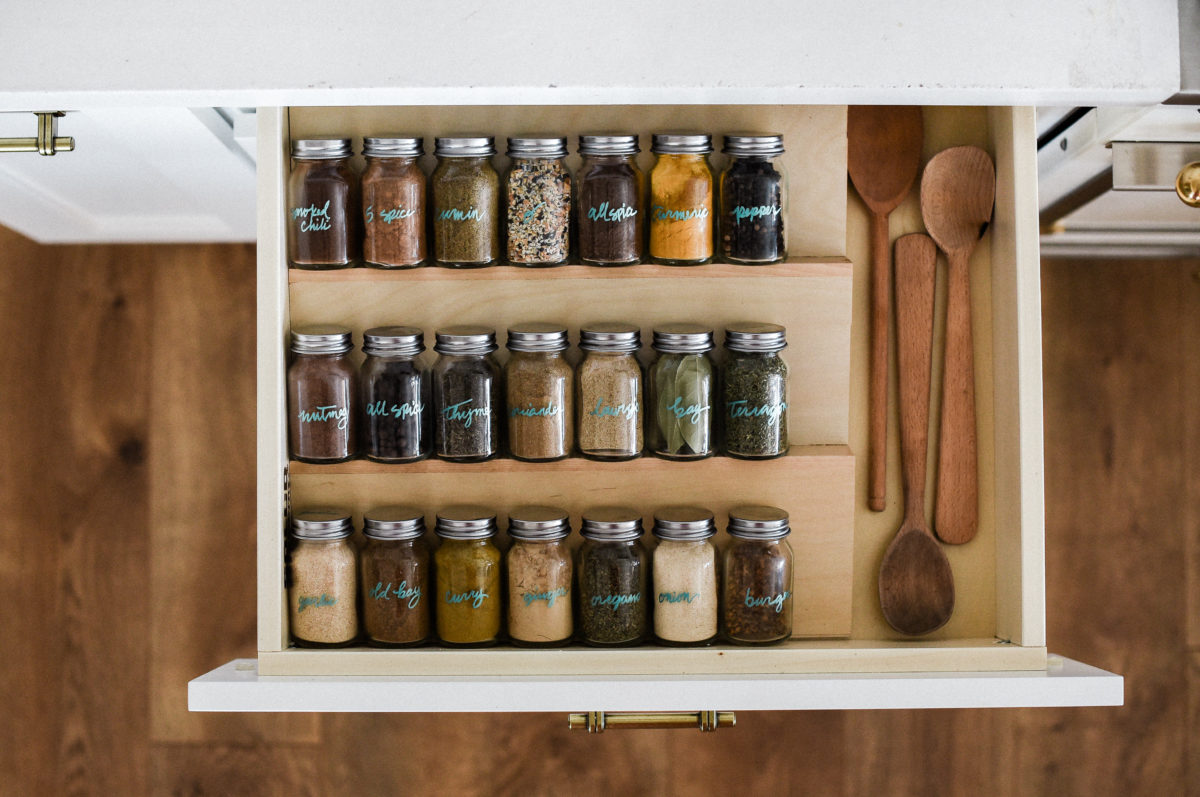
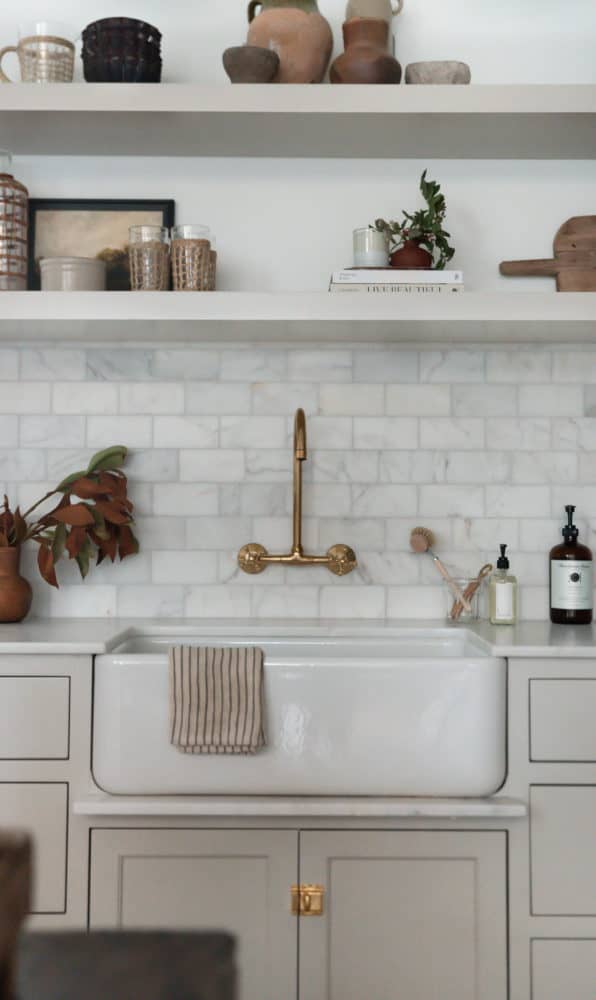
- Opt for Open Shelving
I have a love-hate relationship with open shelving. While I tend to find them a bit dated, they do happen to look quite nice in a farmhouse kitchen.
I have pretty strict rules though (when we are designing for clients): no thicker than 1.5″ and I like them to be wood (occasionally painted), with a bracket or some sort of detail.
Size and structure
Keep shelf thickness to 1.5 inches – anything thicker feels clunky. For support, go with traditional iron brackets in black or aged brass. The brackets should have detail but nothing too fussy.
Paint color
Paint your shelves to match your cabinetry for a seamless look. If you’re using wood, consider:
- Painted the same as your cabinetry for a classic feel.
- Reclaimed barn wood for an authentic rustic vibe.
- Quarter-sawn oak if you’re going after those natural wood accents.
Placement tips
- Frame a window with equal-length shelves on each side.
- Stack them between tall cabinet doors for a built-in look.
- Use them to bridge the gap between cabinets around a range hood.
What goes where
- Bottom shelves: Daily-use items like plates and bowls.
- Upper shelves: Less-used pieces and decorative items.
- Keep it functional, everything should be within easy reach for everyday use.
- Maximize Kitchen Islands
Old-school farmhouse kitchens never had built-in islands – they had work tables. That’s why the best rustic farmhouse kitchen island today takes its cues from furniture. A weathered farm table or antique butcher block adds character that no brand-new built-in can match.
The base setup
The bottom of your island should breathe. Open shelving loaded with baskets, crocks, and everyday gear feels right at home in a traditional farmhouse look. Skip the closed cabinet panels – they’ll make your island feel heavy. Those open legs and airy shelves keep the cooking space casual and welcoming.
Work surface
Wood tops rule in farmhouse style. Butcher block isn’t just pretty – it’s practical. You can work on it and scratches just add character. Maple is highly durable and can withstand significant wear, while oak features attractive grain patterns. Both types of wood can last for a long time if properly maintained.
Making it work
Ensure there is at least 42 inches of walking space around all sides. If you will add seating, allocate 24 inches of width for each person. The main goal of a modern farmhouse design is to achieve the perfect balance between aesthetics and functionality.
Useful additions
Built-in cutting boards, a hidden drawer for linens, and lower shelf storage keep things handy without cluttering up your workspace. The sink belongs against the wall, so keep your island for prep work, just like those old farm tables were meant for.
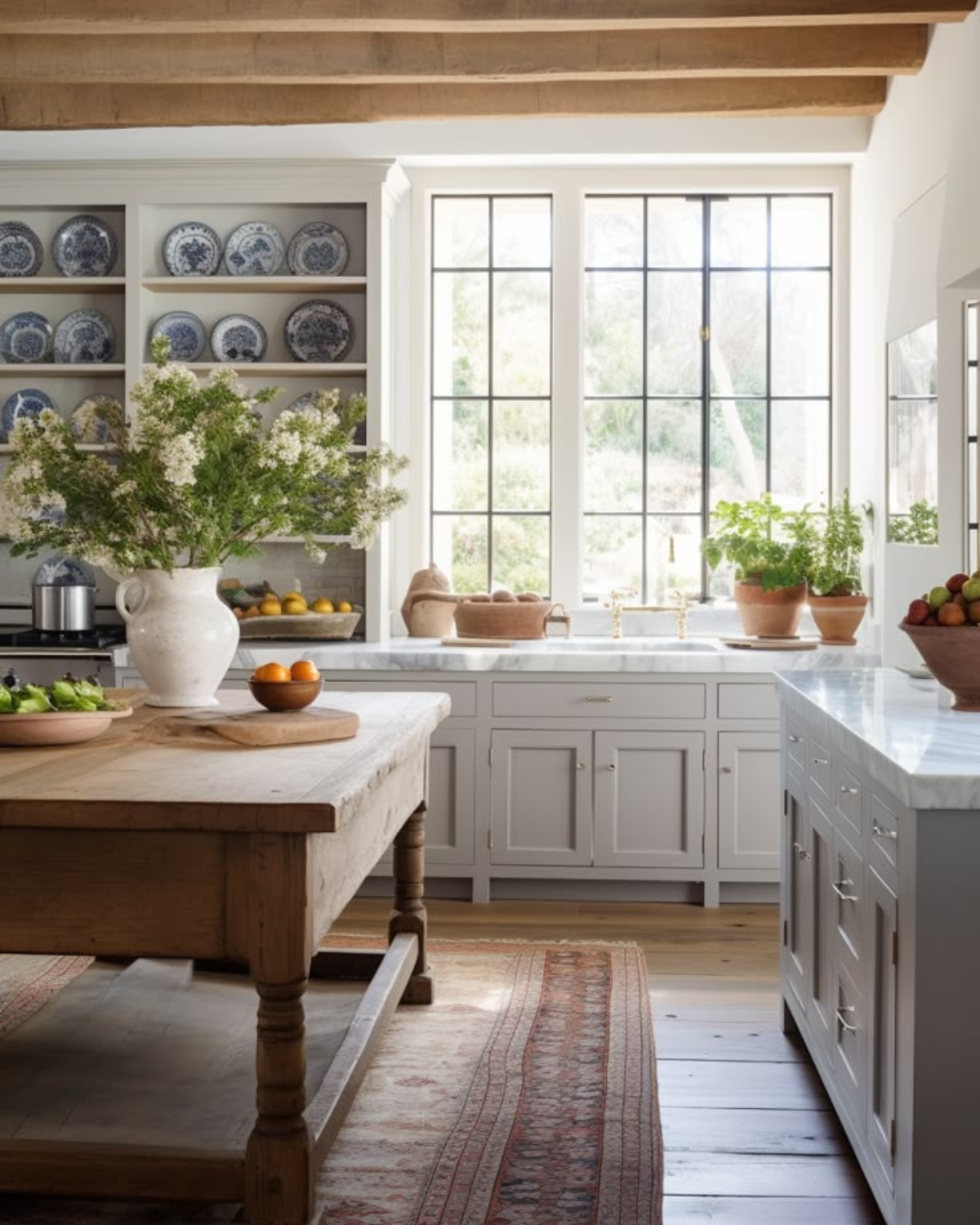
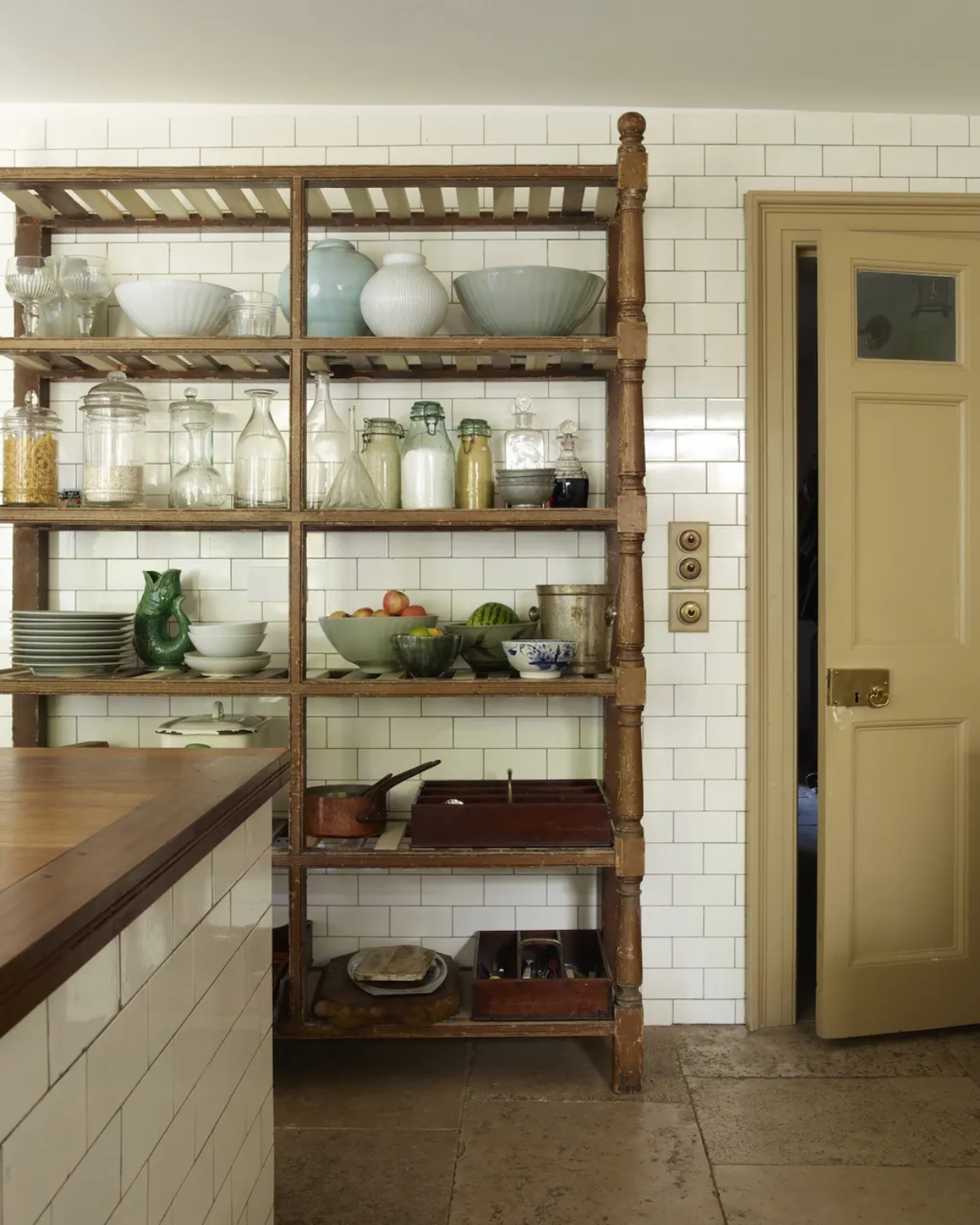
- Go for a Tile, Brick or Backsplash
Selecting the correct backsplash for a farmhouse kitchen is actually quite easy. Most people default to white subway tile – and yes, it’s a great choice. However, and I feel strongly about this, white subway tiles are not created equal.
I suggest opting for a handmade subway (try Heath, Fireclay, or Country Floors), or marble.
If you select something from a big box store, you may not get that handmade, authentic look you’re after. What you want are handmade ceramic tiles with little waves in the glaze and slight variations in size. Perfectly imperfect!
I like the Modern Farmhouse Brick from Fireclay, as we use it often. These handmade ceramics cost a bit more, but they will make your modern farmhouse kitchen design truly stand out.
Playing with height
Height-wise, 18 inches up from the counter is standard. Behind the stove, though, take it up to the hood.
You can also opt to just do a single rod with a pencil trim cap, I actually did that in my own kitchen.
Beyond basic white
The beautiful thing about farmhouse kitchen style is that you can play around a bit with color and pattern. White isn’t your only option. Soft cream, pale gray or barely-there blue can work if it meshes with your color scheme.
I also absolutely LOVE a hand painted Delft or floral!
Mix materials
Try combining different elements, you don’t have to go with tile backsplash.
You can also try slab behind the range as a splash. You can even use a beadboard!
Don’t stress about perfect installation. The grout matters as much as the tile. Medium gray or cream grout offer a time-worn farmhouse feel without looking dirty {READ: Grout Guide}. And don’t worry if your handmade tiles aren’t perfectly aligned – those slight irregularities make it feel authentic.
- Choose Colors Found in Nature
Traditional farmhouse kitchens feature neutral tones, such as mushroom and taupe. For cabinets, Farrow & Ball’s Denimes blue brings in nature without overwhelming the space. Their Hay shade works well, too – it’s subtle but adds character. Navy lower cabinets paired with oak uppers or an island create that lived-in farmhouse feel. Overall, choose classic, muted colors.
Paint picks (my recommendations)
- Walls: F&B Skimming Stone (blends with grey slate floors and dark brown wooden floorboards and bridges warm brown and cool grey).
- Cabinets: F&B De Nimes or Green Smoke (adds sage tones that work in both small and large kitchens).
- Trim: F&B Pointing (a beautiful neutral that stands out against any color it is paired with).
- Island: F&B Pigeon (brings warmth to any space and has extraordinary response to every kind of light).
If you are going for a modern farmhouse style, deep forest greens, and even the softest yellows work when balanced with natural textures. But keep the overall palette grounded – two-three colors max, plus wood tones.
A good guideline is to layer neutral colors that have subtle variations. Mix warm whites, soft grays, and natural materials. Add color through changeable accents – curtains, pottery, and even copper pots hanging on the wall. This way, your kitchen stays true to its farmhouse roots while reflecting your style.
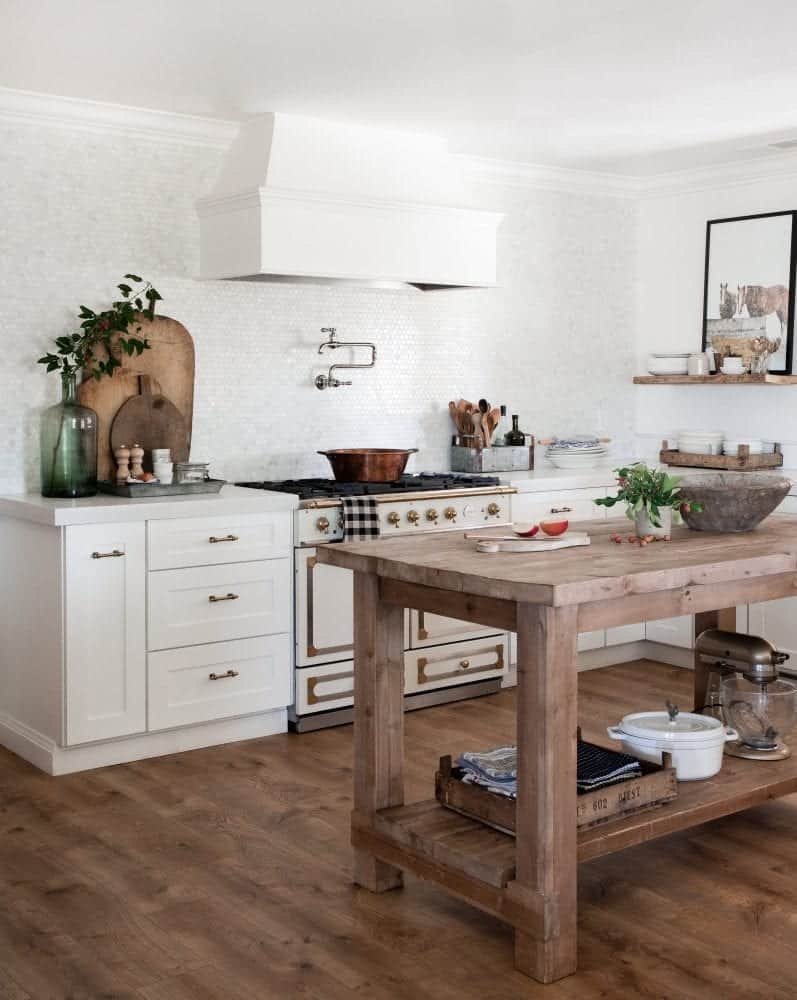
Conclusion
What truly makes a farmhouse kitchen notable is how everything comes together to tell your story. Some clients love classic cream cabinets, while others want to go bold with navy. Either way works, as long as the elements are inviting and classic. Let your space tell its story through warm woods, handmade touches, and colors that feel like they’ve always belonged.
Need Help Making It Happen? We can do that! Let’s connect!
There are many farmhouse kitchen ideas online, which can be overwhelming. So, let’s sit down for 60 minutes and plan out your perfect farmhouse kitchen. I will help you craft a complete an overall design tailored to your home’s architecture and needs!
We’ll tackle everything: which cabinet style works with your house, where to splurge and save, and how to nail that timeless farmhouse feel without going overboard on the trends.
Let’s connect – check my calendar for available design consultation times.
Book Your Virtual Kitchen Consultation!
Explore all about Paints and Finishes
Be sure to check out our paint-related articles to dive deeper into color trends, techniques, and tips for your next project! Whether you’re looking to refresh your living room or discover the best finishes for your exterior, we’ve got you covered. Stay inspired and get the best advice for all your painting projects!
Designer’s Review: Sherwin Williams Pure White SW7005
The Best Red Paint Color Ideas to Transform Your Space
A Designer’s Guide to the Best Warm White Paint Colors

instant download
Little Black Book of Color
Download our free paint guide! Get our expert guidance for your entire home with our 30 page paint guide.
The exclusive Boxwood Avenue paint guide to achieve a perfectly cohesive palette in your home!
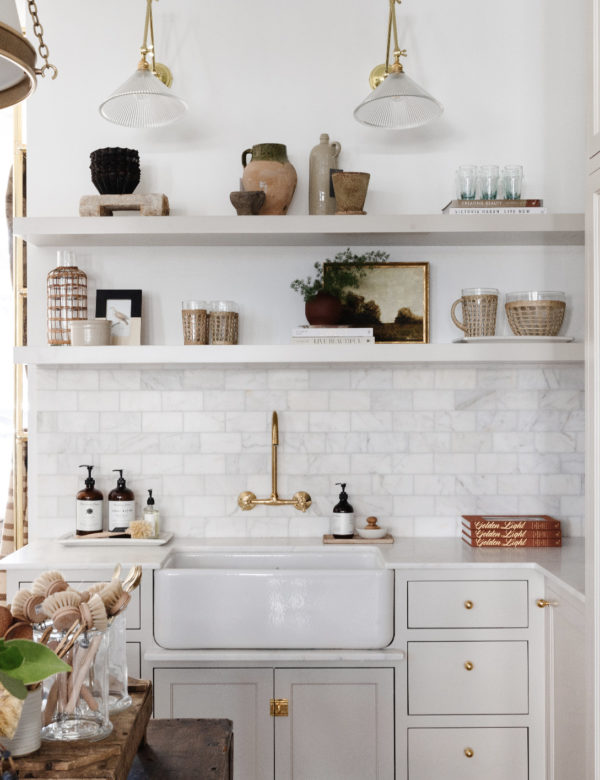
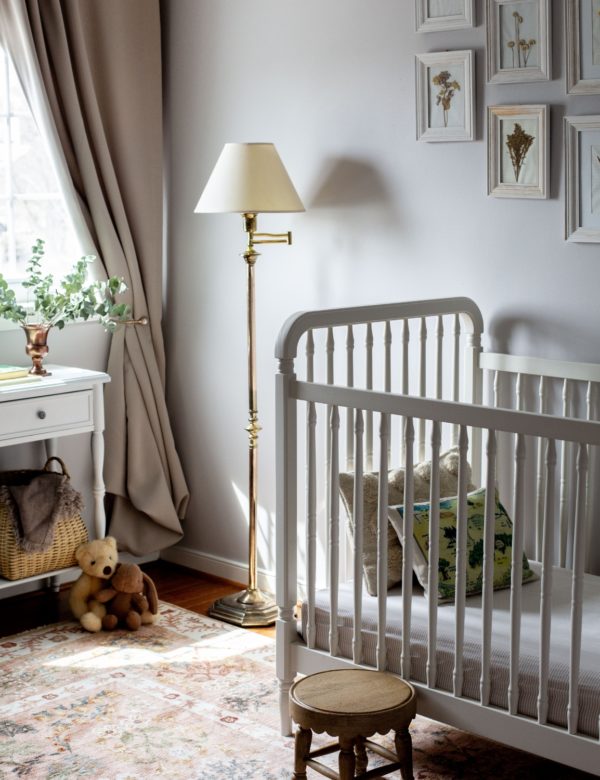
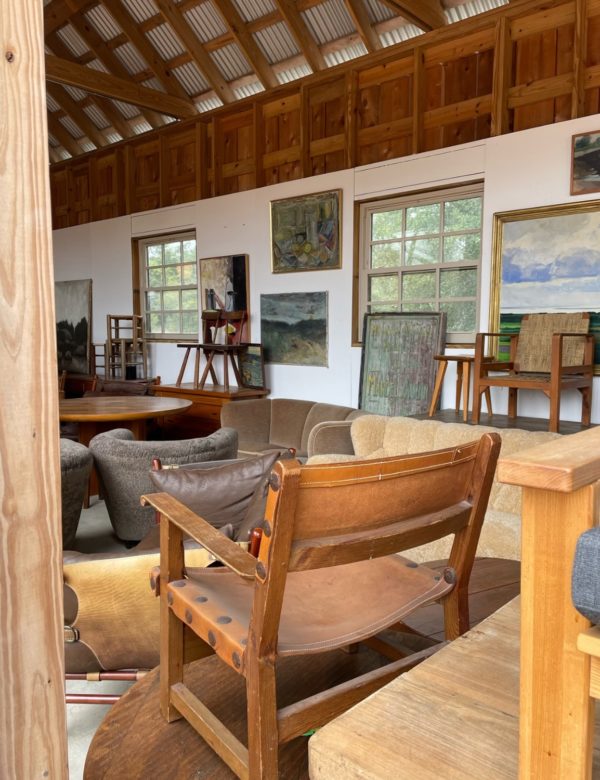
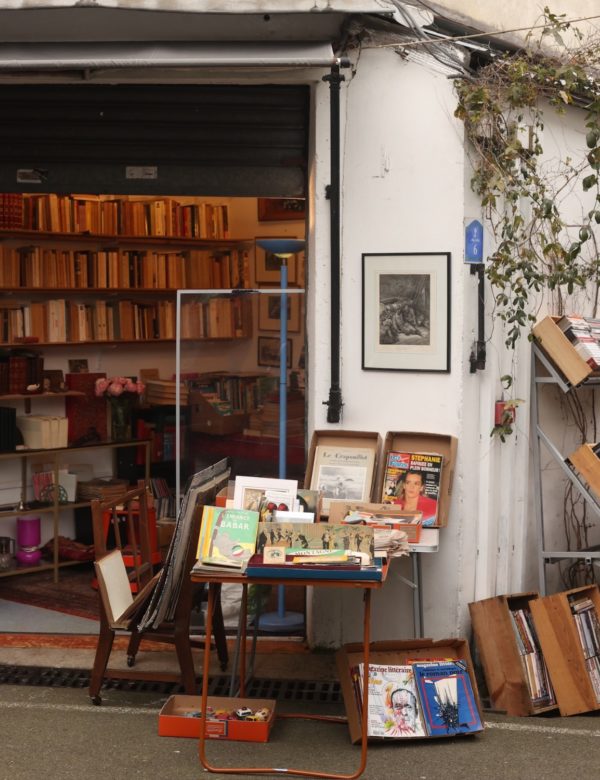
Bless you designed for presenting modern up-dates concerning the anxiety, As i watch for browse alot more. cbd gummies with thc for pain
Appreciate it intended for placing a really good document! I stumbled upon your blog perfect for the desires. Its full of superb in addition to very helpful threads. Sustain the favorable do the job! thca vale
An individual’s song is certainly impressive. You will have certain rather qualified musicians and artists. That i like everyone one of the best for results. carts weed prices
I really liked the selection of ideas – the atmosphere of coziness and practicality is felt in every detail. The idea with open shelves and natural materials especially resonated. When I was arranging my own kitchen in a similar style, I faced the choice of furniture – I wanted something warm and durable. Then I came across reviews of Furniture Row https://furniture-row.pissedconsumer.com/review.html , and although the opinions there were different, they helped me understand what to pay attention to when buying. As a result, I managed to create a space in which it is pleasant to be every day.
Dora Zbierlund may not headline tabloid stories or host talk shows, but her role in shaping 1980s television endures in quiet, meaningful ways. dora zbierlund
Hi there! Nice stuff, do keep me posted when you post again something like this! bola hit
Speed Stars is a brilliant reminder that great gameplay doesn’t need flashy graphics — just skill, timing, and obsession.
I couldn’t agree more with the sentiment that farmhouse kitchens hold a unique charm that transcends time. The way they effortlessly blend warmth and functionality is truly captivating. Your description of farmhouse kitchens as spaces that evoke a sense of welcome and nostalgia resonates deeply. It’s fascinating how elements like worn butcher blocks or carefully crafted cabinets can infuse a kitchen with soul and character.
As an interior designer specializing in farmhouse kitchens, your expertise shines through in capturing the essence of these spaces. Your focus on the intricate details that make farmhouse kitchens special is inspiring. It goes to show that true design excellence lies in the thoughtful curation of elements that stand the test of time. Your passion for creating inviting and timeless kitchen environments is truly commendable.
By the way, I’ve been exploring innovative design concepts on 67 Clicker
Looking for a safe space to de-stress after a hard day? Joi is your personal, non-judgmental listener, available 24/7. Find peace and relaxation by talking to her here: https://joi.com You can let off steam, complain about your boss, or just share your mood in silence. Joi is trained to provide emotional support, calm you down, and help you relax without any pressure or judgment.
Love the idea of cozy farmhouse kitchens! They really do make a house feel like a home, perfect for sharing stories and making memories. Speaking of sharing fun moments, sometimes we switch gears and have a blast playing games like gartic phone online with friends. Can’t wait to see these design ideas!